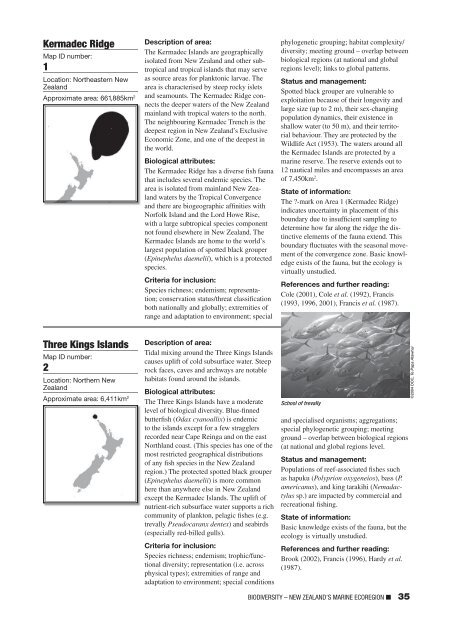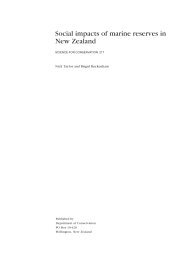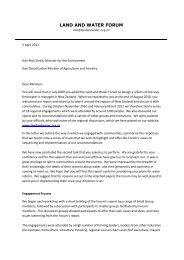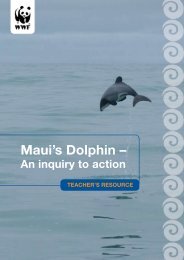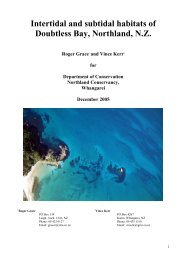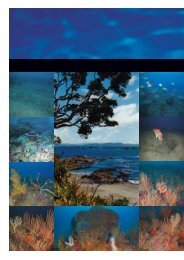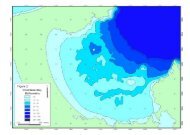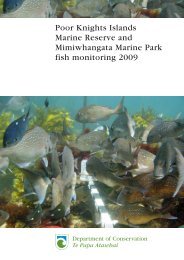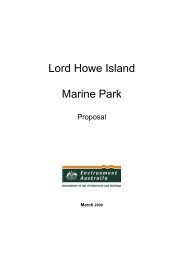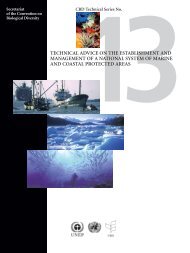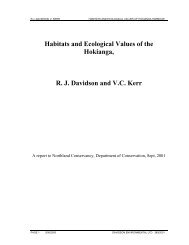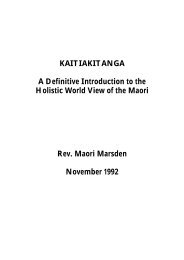WWF Shining a spotlight on the biodiversity of ... - MarineNZ.org.nz
WWF Shining a spotlight on the biodiversity of ... - MarineNZ.org.nz
WWF Shining a spotlight on the biodiversity of ... - MarineNZ.org.nz
Create successful ePaper yourself
Turn your PDF publications into a flip-book with our unique Google optimized e-Paper software.
Kermadec Ridge<br />
Map ID number:<br />
1<br />
Locati<strong>on</strong>: Nor<strong>the</strong>astern New<br />
Zealand<br />
Approximate area: 661,885km 2<br />
Descripti<strong>on</strong> <strong>of</strong> area:<br />
The Kermadec Islands are geographically<br />
isolated from New Zealand and o<strong>the</strong>r subtropical<br />
and tropical islands that may serve<br />
as source areas for plankt<strong>on</strong>ic larvae. The<br />
area is characterised by steep rocky islets<br />
and seamounts. The Kermadec Ridge c<strong>on</strong>nects<br />
<strong>the</strong> deeper waters <strong>of</strong> <strong>the</strong> New Zealand<br />
mainland with tropical waters to <strong>the</strong> north.<br />
The neighbouring Kermadec Trench is <strong>the</strong><br />
deepest regi<strong>on</strong> in New Zealand’s Exclusive<br />
Ec<strong>on</strong>omic Z<strong>on</strong>e, and <strong>on</strong>e <strong>of</strong> <strong>the</strong> deepest in<br />
<strong>the</strong> world.<br />
Biological attributes:<br />
The Kermadec Ridge has a diverse fish fauna<br />
that includes several endemic species. The<br />
area is isolated from mainland New Zealand<br />
waters by <strong>the</strong> Tropical C<strong>on</strong>vergence<br />
and <strong>the</strong>re are biogeographic affinities with<br />
Norfolk Island and <strong>the</strong> Lord Howe Rise,<br />
with a large subtropical species comp<strong>on</strong>ent<br />
not found elsewhere in New Zealand. The<br />
Kermadec Islands are home to <strong>the</strong> world’s<br />
largest populati<strong>on</strong> <strong>of</strong> spotted black grouper<br />
(Epinephelus daemelii), which is a protected<br />
species.<br />
Criteria for inclusi<strong>on</strong>:<br />
Species richness; endemism; representati<strong>on</strong>;<br />
c<strong>on</strong>servati<strong>on</strong> status/threat classificati<strong>on</strong><br />
both nati<strong>on</strong>ally and globally; extremities <strong>of</strong><br />
range and adaptati<strong>on</strong> to envir<strong>on</strong>ment; special<br />
phylogenetic grouping; habitat complexity/<br />
diversity; meeting ground – overlap between<br />
biological regi<strong>on</strong>s (at nati<strong>on</strong>al and global<br />
regi<strong>on</strong>s level); links to global patterns.<br />
Status and management:<br />
Spotted black grouper are vulnerable to<br />
exploitati<strong>on</strong> because <strong>of</strong> <strong>the</strong>ir l<strong>on</strong>gevity and<br />
large size (up to 2 m), <strong>the</strong>ir sex-changing<br />
populati<strong>on</strong> dynamics, <strong>the</strong>ir existence in<br />
shallow water (to 50 m), and <strong>the</strong>ir territorial<br />
behaviour. They are protected by <strong>the</strong><br />
Wildlife Act (1953). The waters around all<br />
<strong>the</strong> Kermadec Islands are protected by a<br />
marine reserve. The reserve extends out to<br />
12 nautical miles and encompasses an area<br />
<strong>of</strong> 7,450km 2 .<br />
State <strong>of</strong> informati<strong>on</strong>:<br />
The ?-mark <strong>on</strong> Area 1 (Kermadec Ridge)<br />
indicates uncertainty in placement <strong>of</strong> this<br />
boundary due to insufficient sampling to<br />
determine how far al<strong>on</strong>g <strong>the</strong> ridge <strong>the</strong> distinctive<br />
elements <strong>of</strong> <strong>the</strong> fauna extend. This<br />
boundary fluctuates with <strong>the</strong> seas<strong>on</strong>al movement<br />
<strong>of</strong> <strong>the</strong> c<strong>on</strong>vergence z<strong>on</strong>e. Basic knowledge<br />
exists <strong>of</strong> <strong>the</strong> fauna, but <strong>the</strong> ecology is<br />
virtually unstudied.<br />
References and fur<strong>the</strong>r reading:<br />
Cole (2001), Cole et al. (1992), Francis<br />
(1993, 1996, 2001), Francis et al. (1987).<br />
Three Kings Islands<br />
Map ID number:<br />
2<br />
Locati<strong>on</strong>: Nor<strong>the</strong>rn New<br />
Zealand<br />
Approximate area: 6,411km 2<br />
Descripti<strong>on</strong> <strong>of</strong> area:<br />
Tidal mixing around <strong>the</strong> Three Kings Islands<br />
causes uplift <strong>of</strong> cold subsurface water. Steep<br />
rock faces, caves and archways are notable<br />
habitats found around <strong>the</strong> islands.<br />
Biological attributes:<br />
The Three Kings Islands have a moderate<br />
level <strong>of</strong> biological diversity. Blue-finned<br />
butterfish (Odax cyanoallix) is endemic<br />
to <strong>the</strong> islands except for a few stragglers<br />
recorded near Cape Reinga and <strong>on</strong> <strong>the</strong> east<br />
Northland coast. (This species has <strong>on</strong>e <strong>of</strong> <strong>the</strong><br />
most restricted geographical distributi<strong>on</strong>s<br />
<strong>of</strong> any fish species in <strong>the</strong> New Zealand<br />
regi<strong>on</strong>.) The protected spotted black grouper<br />
(Epinephelus daemelii) is more comm<strong>on</strong><br />
here than anywhere else in New Zealand<br />
except <strong>the</strong> Kermadec Islands. The uplift <strong>of</strong><br />
nutrient-rich subsurface water supports a rich<br />
community <strong>of</strong> plankt<strong>on</strong>, pelagic fishes (e.g.<br />
trevally Pseudocaranx dentex) and seabirds<br />
(especially red-billed gulls).<br />
Criteria for inclusi<strong>on</strong>:<br />
Species richness; endemism; trophic/functi<strong>on</strong>al<br />
diversity; representati<strong>on</strong> (i.e. across<br />
physical types); extremities <strong>of</strong> range and<br />
adaptati<strong>on</strong> to envir<strong>on</strong>ment; special c<strong>on</strong>diti<strong>on</strong>s<br />
School <strong>of</strong> trevally<br />
and specialised <strong>org</strong>anisms; aggregati<strong>on</strong>s;<br />
special phylogenetic grouping; meeting<br />
ground – overlap between biological regi<strong>on</strong>s<br />
(at nati<strong>on</strong>al and global regi<strong>on</strong>s level.<br />
Status and management:<br />
Populati<strong>on</strong>s <strong>of</strong> reef-associated fishes such<br />
as hapuku (Polypri<strong>on</strong> oxygeneios), bass (P.<br />
americanus), and king tarakihi (Nemadactylus<br />
sp.) are impacted by commercial and<br />
recreati<strong>on</strong>al fishing.<br />
State <strong>of</strong> informati<strong>on</strong>:<br />
Basic knowledge exists <strong>of</strong> <strong>the</strong> fauna, but <strong>the</strong><br />
ecology is virtually unstudied.<br />
References and fur<strong>the</strong>r reading:<br />
Brook (2002), Francis (1996), Hardy et al.<br />
(1987).<br />
BIODIVERSITY – NEW ZEALAND’S MARINE ECOREGION ■ 35<br />
©2004 DOC, Te Papa Atawhai


